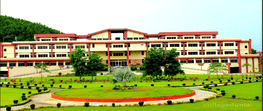Dr. Tarali Kalita, Head of the Department of Computer Science at NERIM Group of Institutions. With more than 14 years of experience in her field, Dr. Tarali brings a wealth of knowledge and a passion for education that is infectious. She got her Master of Computer Application from Dibrugarh University and her PhD in Networking from Gauhati University. Her areas of interest include Networking, Database Management Systems and Software Engineering. Dr. Kalita has a number of publications in various scientific international journals.

What are the factors that make this program the best for the students to opt?
A good program should include a thorough curriculum covering a variety of computer science subjects, such as databases, artificial intelligence, machine learning, programming languages, algorithms, data structures, and software engineering. Students can concentrate on subjects related to their interests and professional aspirations by choosing a specialisation. A course that gives students the chance to conduct research can be very helpful. Research experience can result in publications and networking possibilities, in addition to improving critical thinking and problem-solving abilities.
What will you say are the “best practices” in the course you’re offering?
For each of our courses, we ensure to have learning objectives clearly stated. This aids students in understanding what they should know and be able to do by the end of the course. Throughout the course, we use a range of evaluation methods, such as projects, examinations, quizzes, and presentations. This offers a comprehensive assessment of the advancement of the kids. Additionally, we make use of coding environments, simulation software, and technological tools to improve learning and make concepts easier to apply practically.
How did you train yourself/faculty to deliver this program to the students?
Since computer science is a technological area, faculty personnel are trained in incorporating technology into their instruction. Using virtual labs, coding platforms, simulation tools, and other instructional technology may fall under this category. Effective communication strategies for engrossing lectures, fostering discussions, and giving students feedback might all be included in the training. This covers methods for explaining difficult ideas to a wide range of people.
How do you tend to build an industry connected with this program?
We establish connections with tech firms to provide students with co-ops and internships. Students can gain practical experience, improve their skills and get exposure to real-world initiatives. Organise seminars, workshops, and guest lectures with professionals in the field. They can exchange knowledge on emerging trends, technological advancements, and professional difficulties. We have created a curriculum in partnership with business partners to guarantee that students acquire the most recent and applicable skills needed by companies.
What were the challenges that you faced while inculcating this program in your curriculum?
It can be difficult to create a thorough and current curriculum that strikes a balance between fundamental information and cutting-edge technologies. Careful planning is necessary to strike the correct balance between theory and real-world applications. Additional resources, like faculty experience, up-to-date facilities, software licences, and upgraded hardware, are frequently needed when launching a new program. The availability of resources and budgetary restrictions may also be obstacles. It can be difficult to win over current academics, students, and administration to the new program. It is also essential to persuade stakeholders of the program's worth and advantages.
What are the types of projects that the students are working on through this program?
The focus, specialisation areas, and industry links of a computer science programme can greatly influence the kinds of projects that students work on. Students may design software applications, which can include desktop software, online apps, and mobile apps. These projects may include developing algorithms, creating user interfaces, and making sure they are effective and user-friendly. Interactive video games are made as part of game development projects. Students may also work on things like artificial intelligence, graphics, physics engines, game design, and multiplayer capabilities.
What are the benefits and career options after pursuing this course?
Enrolling in a computer science program has several advantages. It provides a broad range of employment opportunities in a world driven by technology and changing quickly. The tech sector is expanding, and there is a strong demand for qualified computer scientists in many different fields. A proficiency in computer science can be applied in a wide range of sectors, including healthcare, finance, entertainment, and education.

![NERIM Group of Institutions - [NERIM]](https://image-static.collegedunia.com/public/college_data/images/appImage/1593459187Cover.jpg?h=240&w=1000&mode=crop)
![NERIM Group of Institutions - [NERIM]](https://image-static.collegedunia.com/public/college_data/images/logos/1625290156head.jpg?h=71.7&w=71.7&mode=stretch)

















![Assam Institute of Management - [AIM]](https://image-static.collegedunia.com/public/college_data/images/appImage/17261_AIM_New.png?h=111.44&w=263&mode=stretch)







![Flywayy Institute of Air Hostess Training - [FIAT]](https://image-static.collegedunia.com/public/college_data/images/appImage/undefined?h=111.44&w=263&mode=stretch)

![Third Eye College - [TEC]](https://image-static.collegedunia.com/public/college_data/images/appImage/57585_cvr.png?h=111.44&w=263&mode=stretch)

![MBA/PGDM | admission | 2024 | Narsee Monjee Institute of Management Studies - [NMIMS Deemed to be University]](https://image-static.collegedunia.com/public/college_data/images/logos/1506323004Logo.jpg?h=72&w=72&mode=stretch)




![MBA/PGDM | admission | 2024 | Indian Institute of Management - [IIMC]](https://image-static.collegedunia.com/public/college_data/images/logos/1488950580d2.png?h=72&w=72&mode=stretch)

















.png?h=72&w=72&mode=stretch)




.png?h=72&w=72&mode=stretch)
.png?h=72&w=72&mode=stretch)
.png?h=72&w=72&mode=stretch)
.png?h=72&w=72&mode=stretch)

![Assam Don Bosco University - [ADBU]](https://image-static.collegedunia.com/public/college_data/images/logos/1685714174logo.png?h=72&w=72&mode=stretch)



![Assam down town University - [ADTU]](https://image-static.collegedunia.com/public/college_data/images/logos/1714548748adtunewlogo.png?h=72&w=72&mode=stretch)
![Gauhati University - [GU]](https://image-static.collegedunia.com/public/college_data/images/logos/1394864857Gauhati University.png?h=72&w=72&mode=stretch)
![Girijananda Chowdhury Institute of Management & Technology - [GIMT]](https://image-static.collegedunia.com/public/college_data/images/logos/1714384620Other.png?h=72&w=72&mode=stretch)
![Asian Institute of Management and Technology - [AIMT]](https://image-static.collegedunia.com/public/college_data/images/logos/1588338362aimtlogo.png?h=72&w=72&mode=stretch)

![University of Science and Technology - [USTM]](https://image-static.collegedunia.com/public/college_data/images/logos/1421309174University_of_Science_and_Technology,_Meghalaya_seal.jpg?h=72&w=72&mode=stretch)


![Royal Global University - [RGU]](https://image-static.collegedunia.com/public/college_data/images/logos/1744450599download.jpg?h=72&w=72&mode=stretch)





Comments